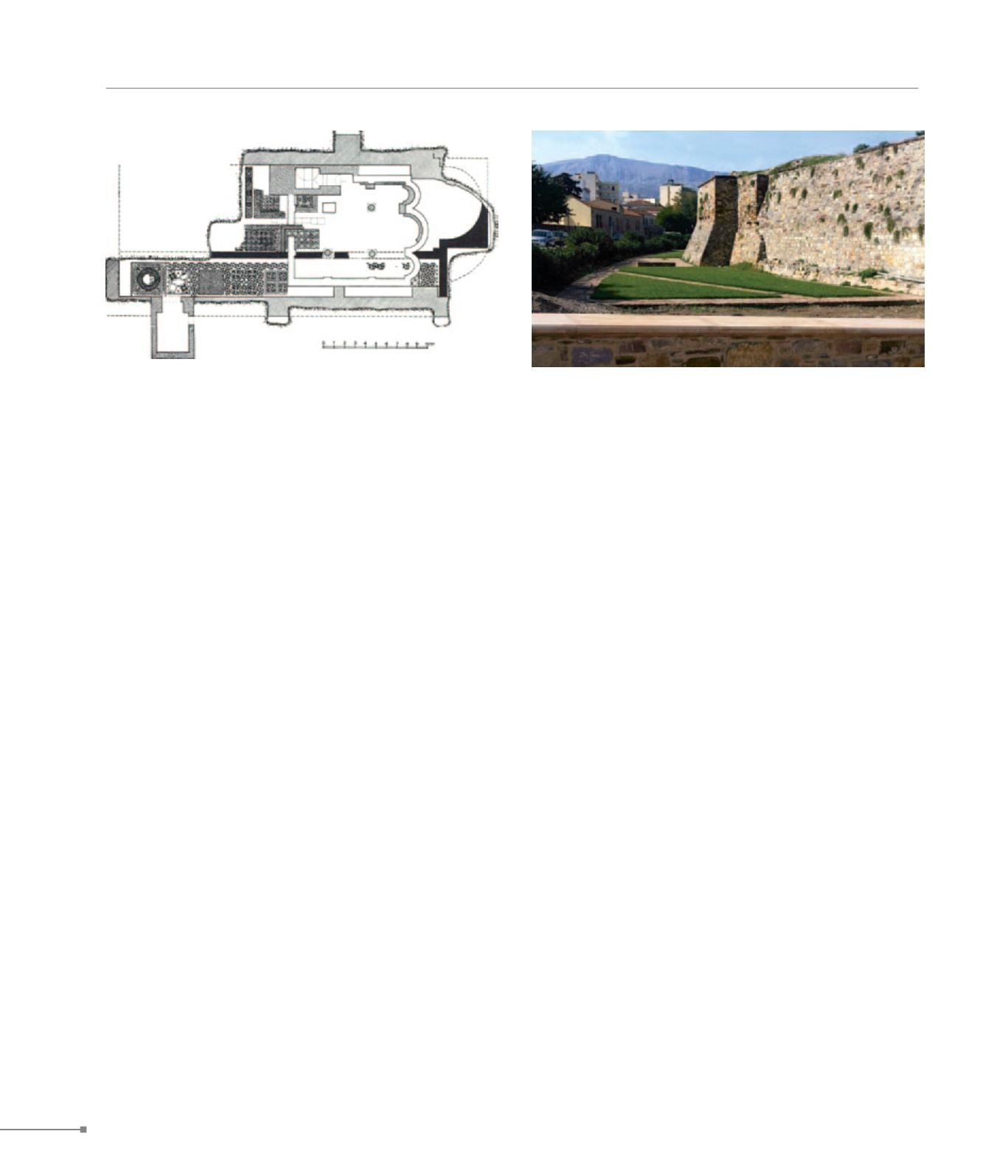
573. Chios
573. Chios
THE ISLANDS
324
573. Chios, Aghios Isidoros basilica, ground plan (Χίος, βασιλική του
Αγίου Ισιδώρου, κάτοψη)
573. Chios, Castle, trench (Χίος, κάστρο, τάφρος)
with groin vaults supported by eight piers. The E stoa may be
dated from the Byzantine years, but the rest is allocated to the
Genoese occupation period (1346-1566).
In the centre of the fortress stands the church of Saint George.
According to the sources, a Byzantine church already existed
from the 10th or 11th c., on whose site a three-aisled basilica
was built during the Genoese occupation, from which two in-
tricate marble pedestals survive. Towards the S section of the
fortress are remains of a basilica mentioned in sources since
the mid-15th c., also dedicated to Saint George. The church of
Saint George at Kechri is S of the fortress and part of a Byzan-
tine naiskos. E of the present church of Saint Nicholas in the
S section of the fortress, remnants, possibly of the Early Chris-
tian period, have been discovered. In the neighbourhood of
Letsaina, N of Chios town, has been found a church with many
building phases. It was dedicated to Aghios Isidoros, patron
saint of Chios. Initially, possibly in the mid-5th c., it was a three-
aisled basilica with a horseshoe-shaped conch. In a second
phase the basilica was transferred to the S and the conch be-
came semicircular. In the mid-6th c. a new, large three-aisled
church was built, which, before the 14th c, was converted into
a domed, cross-in-square design. In Demogerontias Street, in
the centre of Chios town, an Early Christian building has been
excavated with a mosaic featuring a pseudo-emblem, typical
of the Justinian period. On the E façade of the present-day
church of Saint Nicholas in the same street there is some Byz-
antine masonry with ceramic rosettes.
At the S entrance of the city of Chios, at the Limnos site, there
survives a rectangular Gothic tower (first half of the 15th c.)
whose exterior surfaces are covered with stones from Thymi-
ana (“thymianousikes”). It has two arched openings and the
main space is roofed with two groin vaults; in the E are two
rooms. Another tower, Kammenos Pyrgos, lies at the S en-
trance of the modern town. It is a two-storey structure with
groin vaults in the interior. On the lintel of the entrance is dis-
played the Giustinianis’ coat of arms, dating from the period
of Byzantine domination of Chios, before 1346, or from the
period of Genoese occupation. On the SW side of the town, at
Aghios Spyridon, there is an element of the water supply from
the period of Genoese occupation. Known as Koris Gefyri, it
is the arcade of an aqueduct constructed in the 15th c. Over
the river Koufos, in the vicinity of Latomeio, is a bridge that is
part of an aqueduct, possibly of the 15th c., and also of the
Genoese era. It consists of five bases connected with pointed
arches; two more bases survive.
Pityos. (2)
Pityos is a fortified medieval settlement resembling the defen-
sive mountain villages of the island, with numerous innovatory
alterations. It was first mentioned in 1259 as a metochion of
Nea Moni or as a name for other metochia of this monastery.
In 1362 it was the seat of the Castellany, while in 1420 it was
attested as a castle city. The church of the Theotokos Spi-
laiotissa, mentioned in 1315-6, has not survived. The large,
polygonal tower of Pityos stands at the edge of the village, at
the conflux of the rivers Kardamylitis and Elinta. Today it is on
two levels; the original entrance opened on the first floor. The
structure features three building phases, with the initial one
(Byzantine) dating from the 13th c.
Kardamyla. (3)
The “Kastro Grias” is a fortress standing on a rocky mountain
top above Kardamyla. Dating from the middle ages, it has two
circular towers, the remains of a cistern and part of the defen-
sive walls.
Viki or Vikoi. (4)
Written attestations about this site start from 1379 when it was
mentioned as the castellan’s seat, as a castle, and as a vil-
lage at Apano Meria. On Aghioi Apostoloi hill the single-nave
naiskos (dedication the same) was constructed with ancient
building material and features Post-Byzantine wall-paintings.
Kampia. (5)
The fortress known as Kastraki of Aghia Paraskevi, dating from
the early Genoese occupation, dominates the top of a steep


